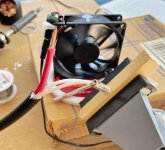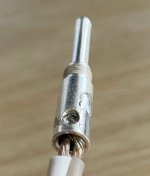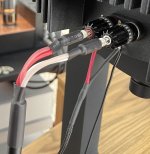He is using Cardas solder.
See post #13.
Cardas manufactures welding wire? Wow, I bet they must sound great if we use it as a cable to connect speakers ....😀
I just checked and the Cardas I have does not have lead. Trithetic or something like that.
I am a green guy in all that I can, but lead-free wire is an exception.
But I recognize that thanks to lead-free SMD solders, a lot of reballing people earn their daily livelihood, that's good.🙂
I like Cardas, makes a nice joint.
is that not punishable by law?
A good trip ?😱
I think you mean 'Eutectic'.I just checked and the Cardas I have does not have lead. Trithetic or something like that.
Eutectic simply means the solder contains a mixture of metals which melts at a lower temperature than the melting point of any of its constituents.
The Cardas solder described in my link contains silver, copper, tin and lead: Cardas Solder
Anyhoo, the main reason I have returned to this thread is to learn if you've successfully soldered up your loudspeaker cables yet!

P.S. @ dotneck335, I wish you many successful couplings! 😉
I am waiting to receive new Cardas rosin and Cardas Quad-eutectic solder. I have (the now discontinued) Cardas Tri-eutectic solder (tin, copper, silver). My rosin is from Radio Shack circa 1995 - I figured I’d get good new rosin as it might have all sort of oxidation products in it.
I am thinking of actually using the Cardas Tri-eutectic solder because it has more silver and tin (which has higher conductivity than lead).
What I am actually planning on is:
1- Strip/twist wires
2- Lightly coat wires and inner connector with rosin
3- Secure wire mechanically with deeper screw, removing top screw of the banana (closest to the inlet for the cable)
4- Secure banana in vice and cable so there’s no relative motion
5- Heat up connector+wire with a 100W solder iron (does it matter it is not temp controlled?)
6- Feed solder to screw opening then to connector inlet
7- Let cool
Repeat for other connectors
Any comments?
Thank you!
I am thinking of actually using the Cardas Tri-eutectic solder because it has more silver and tin (which has higher conductivity than lead).
What I am actually planning on is:
1- Strip/twist wires
2- Lightly coat wires and inner connector with rosin
3- Secure wire mechanically with deeper screw, removing top screw of the banana (closest to the inlet for the cable)
4- Secure banana in vice and cable so there’s no relative motion
5- Heat up connector+wire with a 100W solder iron (does it matter it is not temp controlled?)
6- Feed solder to screw opening then to connector inlet
7- Let cool
Repeat for other connectors
Any comments?
Thank you!
I would like to see an image of the Z plug to get a feel of how difficult it would be to solder.
I shouldn't think that a 100W iron should be necessary.
I shouldn't think that a 100W iron should be necessary.
There's a fair mass of metal there, so you will need a hot iron.
However, I suggest you try first with your 50W iron at max temperature.
However, I suggest you try first with your 50W iron at max temperature.
Yes it is not just a terminal.
Just for my own education, is there an issue with using the bigger iron? I wouldn’t let it boil for a while for sure, and I am using vices to keep everything steady as it cools.
Just for my own education, is there an issue with using the bigger iron? I wouldn’t let it boil for a while for sure, and I am using vices to keep everything steady as it cools.
I suppose it's really a toss up beween lower power/longer time and higher power/shorter time. Just watch out for the insulation on the wires melting.
Jings, I'm now thinking you should have bought an extra plug for experimentation purposes!
If it's a metal vice, make sure it doesn't act as a heat sink and draw heat away from the plug. I would insulate the jaws of such a vice using strips of wood..
I hope your next post is a report of your success! 😎
Jings, I'm now thinking you should have bought an extra plug for experimentation purposes!

If it's a metal vice, make sure it doesn't act as a heat sink and draw heat away from the plug. I would insulate the jaws of such a vice using strips of wood..
I hope your next post is a report of your success! 😎
Last edited:
Yeah, I didn't think of buying an extra for experimentation... 🙁
My vice has silicone covered jaws and I will use the screw-on aluminum cover screwed in reverse to hold the banana with minimal heat transfer.
Getting the Cardas rosin tomorrow so prob will do it in the next day or two. I will post a few pics when done.
Thank you so much for the help!!!
My vice has silicone covered jaws and I will use the screw-on aluminum cover screwed in reverse to hold the banana with minimal heat transfer.
Getting the Cardas rosin tomorrow so prob will do it in the next day or two. I will post a few pics when done.
Thank you so much for the help!!!
Hello,
Would suggest using an old sturdy piece of rag that you don't mind burning to hold the piece in the vice while you heat it to solder. Don't need to have additional metal to heat or want to melt you silicon pads.
Would suggest using an old sturdy piece of rag that you don't mind burning to hold the piece in the vice while you heat it to solder. Don't need to have additional metal to heat or want to melt you silicon pads.
Did the job today. Decided to use Cardas Quad-eutectic and Cardas rosin rather than the Cardas Tri-eutectic, as I thought it would flow better. Also used the 100W iron but I would have been just fine with the 50W.
See pics below.
See pics below.
Attachments
The vast majority prefer crimping and avoid soldering.
For good reason at least as of 1994 when I retired. UL, etc., testing proved time and time again that a proper cold welded [crimped] joint was superior in every measured way.
For many [most?] of us though, the cost of such tools, components is a bit much, especially considering how little we would need them, so silver soldering [not just silver based] an inexpensive crimp is 'best of the rest' options available to us.
I agree, GM, I never used silver solder, in fact, I would bet that in my country it is not possible.
But the crimping pliers, there are some inexpensive ones, but they are not for heavy use.
I have gotten to twist one of these just with the use of my hands! (sometimes it is not enough and I use a "parrot beak" clamp open in its maximum position)
Pinza Crimpeadora Pelacable Proskit | Mercado Libre
But the crimping pliers, there are some inexpensive ones, but they are not for heavy use.
I have gotten to twist one of these just with the use of my hands! (sometimes it is not enough and I use a "parrot beak" clamp open in its maximum position)
Pinza Crimpeadora Pelacable Proskit | Mercado Libre
Last edited:
My original cables are Audio Note Kondo silver. But I only have a 10 foot run (per channel) and I need 35 feet in my current setup. So I figured I could ask Audio Note to make a run of 35 feet (per channel) - but you don't even want to know how much that would cost. So I figured I'd buy 70 feet of Canare 4S11 and terminate them myself. And that has worked amazingly well over time (3 years). I just wanted to redo the terminations.
BTW, keep in mind my speakers have 18 ohm impedance so a long run of cable isn't a problem.
BTW, keep in mind my speakers have 18 ohm impedance so a long run of cable isn't a problem.
- Home
- Loudspeakers
- Multi-Way
- Speaker cable connectors: Solder or Screw?



